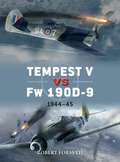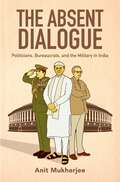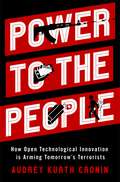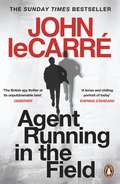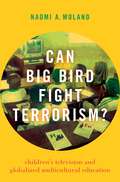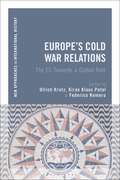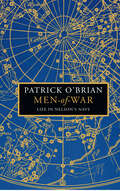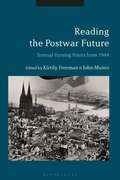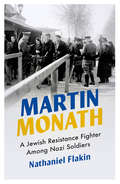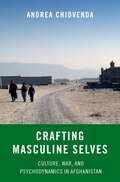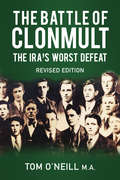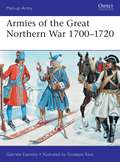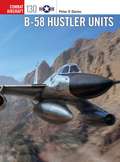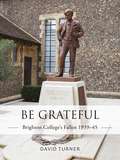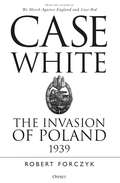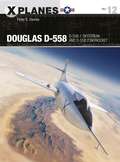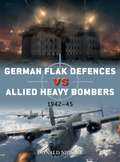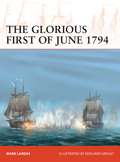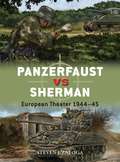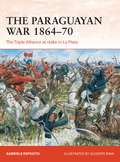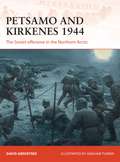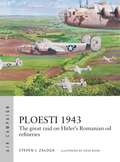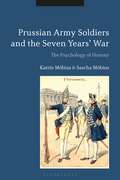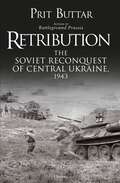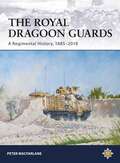- Table View
- List View
Tempest V vs Fw 190D-9: 1944–45 (Duel)
by Robert ForsythArguably two of the finest piston-engined fighters ever built, the Tempest V and Fw 190D-9 raised the bar in terms of aircraft design and operational capability during World War II. The long-nosed 'Dora 9', designed by Kurt Tank, first appeared in the skies over the Western and Eastern Fronts in the late summer of 1944. Fast, and with an exceptional rate of climb, it quickly bettered almost every fighter that the RAF, USAAF and Soviet Red Air Force could field. The Hawker Tempest V entered service in early 1944, initially proving itself a stalwart performer when it was deployed to intercept V1 flying bombs over southern England. From the autumn of 1944, the Tempest V also equipped squadrons of the 2nd Tactical Air Force, operating in support of the Allied armies advancing across north-west Europe. It became a potent ground-attack aircraft, armed with underwing rockets, but also a first-class interceptor when pitted against the Luftwaffe's advanced Fw 190D-9 and Me 262.Featuring full colour artwork, this book describes in fascinating detail combats between the Tempest Vs of No 274 Sqn and the Fw 190D-9s of I. and III./JG 26 between February and April 1945.
The Absent Dialogue: Politicians, Bureaucrats, and the Military in India (Modern South Asia)
by Anit MukherjeeCivilian control over the military is widely hailed as one of the major successes of India's democracy. Because it is so rare, especially among post-colonial states, this control is rightfully celebrated. But has this come at a cost? In The Absent Dialogue, Anit Mukherjee argues that the pattern of civil-military relations in India has hampered its military effectiveness. Diving deep into understanding the organization and internal processes within the Indian military, he explains how Indian politicians and bureaucrats have long been content with the formal and ritualistic exercise of civilian control, while the military continues to operate in institutional silos. Yet, there has been little substantive engagement between the two. To support this claim, Mukherjee closely examines the variables most closely associated with military effectiveness-weapons procurement, jointness (the ability of separate military services to operate together), officer education, promotion policies, and defense planning. Further, Mukherjee shows how India's pattern of civil-military relations-best characterized as an absent dialogue-adversely affects each of these processes. While the book focuses on India, it also highlights the importance of civilian expertise and institutional design in enhancing civilian control and military effectiveness in other democracies. Informed by more than a hundred and fifty interviews and recently available archival material, The Absent Dialogue sheds new light on India's military and will reshape our understanding of both the history and contemporary dynamics of civil-military relations and recurring problems therein.
Power to the People: How Open Technological Innovation is Arming Tomorrow's Terrorists
by Audrey Kurth CroninEssential reading on how technology empowers rogue actors and how society can adapt. Never have so many possessed the means to be so lethal. A dramatic shift from 20th century "closed" military innovation to "open" innovation driven by commercial processes is underway. The diffusion of modern technology--robotics, cyber weapons, 3-D printing, synthetic biology, autonomous systems, and artificial intelligence--to ordinary people has given them access to weapons of mass violence previously monopolized by the state. As Audrey Kurth Cronin explains in Power to the People, what we are seeing now is the continuation of an age-old trend. Over the centuries, from the invention of dynamite to the release of the AK-47, many of the most surprising developments in warfare have occurred because of technological advances combined with changes in who can use them. That shifting social context illuminates our current situation, in which new "open" technologies are reshaping the future of war. Cronin explains why certain lethal technologies spread, which ones to focus on, and how individuals and private groups will adapt lethal off-the-shelf technologies for malevolent ends. Now in paperback with a foreword by Lawrence Freedman and a new epilogue, Power to the People focuses on how to both preserve the promise of emerging technologies and reduce risks. Power is flowing to the people, but the same digital technologies that empower can imperil global security--unless we act strategically.
Agent Running in the Field: A BBC 2 Between the Covers Book Club Pick
by John le CarréPre-order John le Carré's new novel Agent Running in the Field now, and be one of the first to read it.'No other writer has charted - pitilessly for politicians but thrillingly for readers - the public and secret histories of his times' Guardian________________________________Nat, a 47 year-old veteran of Britain's Secret Intelligence Service, believes his years as an agent runner are over. He is back in London with his wife, the long-suffering Prue. But with the growing threat from Moscow Centre, the office has one more job for him. Nat is to take over The Haven, a defunct substation of London General with a rag-tag band of spies. The only bright light on the team is young Florence, who has her eye on Russia Department and a Ukrainian oligarch with a finger in the Russia pie. Nat is not only a spy, he is a passionate badminton player. His regular Monday evening opponent is half his age: the introspective and solitary Ed. Ed hates Brexit, hates Trump and hates his job at some soulless media agency. And it is Ed, of all unlikely people, who will take Prue, Florence and Nat himself down the path of political anger that will ensnare them all. Agent Running in the Field is a chilling portrait of our time, now heartbreaking, now darkly humorous, told to us with unflagging tension by the greatest chronicler of our age._______________________________'John le Carré is as recognisable a writer as Dickens or Austen' Financial Times'No writer has ever been better at turning the act of two people talking politely to each other across a desk into a blood sport' Telegraph
Can Big Bird Fight Terrorism?: Children's Television and Globalized Multicultural Education
by Naomi A. MolandSesame Street has taught generations of Americans their letters and numbers, and also how to better understand and get along with people of different races, faiths, ethnicities, and temperaments. But the show has a global reach as well, with more than thirty co-productions of Sesame Street that are viewed in over 150 countries. In recent years, the United States Agency for International Development (USAID) has provided funding to the New York-based Sesame Workshop to create international versions of Sesame Street. Many of these programs teach children to respect diversity and tolerate others, which some hope will ultimately help to build peace in conflict-affected societies. In fact, the U.S. government has funded local versions of the show in several countries enmeshed in conflict, including Afghanistan, Kosovo, Pakistan, Jordan, and Nigeria. Can Big Bird Fight Terrorism? takes an in-depth look at the Nigerian version, Sesame Square, which began airing in 2011. In addition to teaching preschool-level academic skills, Sesame Square seeks to promote peaceful coexistence-a daunting task in Nigeria, where escalating ethno-religious tensions and terrorism threaten to fracture the nation. After a year of interviewing Sesame creators, observing their production processes, conducting episode analysis, and talking to local educators who use the program in classrooms, Naomi Moland found that this child-focused use of soft power raised complex questions about how multicultural ideals translate into different settings. In Nigeria, where segregation, state fragility, and escalating conflict raise the stakes of peacebuilding efforts, multicultural education may be ineffective at best, and possibly even divisive. This book offers rare insights into the complexities, challenges, and dilemmas inherent in soft power attempts to teach the ideals of diversity and tolerance in countries suffering from internal conflicts.
Europe's Cold War Relations: The EC Towards a Global Role (New Approaches to International History)
This thought-provoking collection analyses the European Community's external relations between 1957 and 1992, with a particular focus upon their broader impact and global significance. Reconceptualizing the long arc of the EC's international role, from its inception in the 1950s to the end of the Cold War, the chapters identify and assess the factors that either supported or impeded Europe's international projection within this period.Organized into three parts, the authors investigate the EC's relations with key countries and world regions, discuss its activities within key policy areas, and offer reflections and conclusions on the various arguments that are put forward. Each chapter considers the entire period from 1957-1992 to identify and explain overarching trends, key decisions and historical conjunctions through scholarly literature, key debates and original discussion of each topic or policy issue. A final chapter situates the main findings within wider contexts, situating the EC in Cold War history. Bringing together international history and international relations, this project allows for cross-disciplinary dialogue and the careful discussion of key concepts, analytical approaches, and empirical findings. Filling a gap in our understanding of the early development of the EC's role as an autonomous global actor, this book holds important messages for the modern day, as the EU's position in global politics continues to shape the world.
Men-of-War: Life In Nelson's Navy
by Patrick O’BrianOut of print for many years, this is a brand new edition of the definitive companion to the acclaimed Aubrey-Maturin series of novels, written by the author himself.
Reading the Postwar Future: Textual Turning Points from 1944
This original collection explores a number of significant texts produced in 1944 that define that year as a textual turning point when overlapping and diverging visions of a new world emerged. The questions posed at that moment, about capitalism, race, empire, nation and cultural modernity gave rise to debates that defined the global politics of their era and continue to delineate our own. Highlighting the goals, agendas and priorities that emerged for artists, intellectuals and politicians in 1944, Reading the Postwar Future rethinks the intellectual history of the 20th century and the way 1944's texts shaped the contours of the postwar world. This is essential reading for any student or scholar of the intellectual, political, economic and cultural history of the postwar era.
Martin Monath: A Jewish Resistance Fighter Among Nazi Soldiers (Revolutionary Lives)
by Nathaniel FlakinA dramatisation of Martin Monath's short life (1913-1944) would need little artistic embellishment; his identity shrouded in mystery, and executed by the Gestapo - twice - the historical record reads like a detective novel.Pieced together for the first time by Wladek Flakin, this biography tells the story of the Jewish socialist and editor of Arbeiter und Soldat ('Worker and Soldier'), and his efforts to turn German rank-and-file soldiers against their Nazi officers in occupied France. Born in Berlin in 1913, Martin Monath was a child of war and revolution. In the 1930s he became a leader of the socialist Zionist youth organisation Hashomer Hatzair in Germany. Fleeing from Berlin to Brussels in 1939, he joined the underground Trotskyist party led by Abraham Leon, and soon became a leading member of the Fourth International in Europe. His relocation to Paris in 1943 saw the birth of Arbeiter und Soldat and his work organising illegal cells of German soldiers for a revolutionary struggle against the Nazis.Drawing on extensive archival research, Flakin uses letters, testimonies and unpublished documents to bring Monath's story to life - weaving a tale rich with conviction and betrayal, ideology and espionage.
Crafting Masculine Selves: Culture, War, and Psychodynamics in Afghanistan
by Andrea ChiovendaAgainst the backdrop of four decades of continuous conflict in Afghanistan, the Pashtun male protagonists of this book carry out their daily effort to internally negotiate, adjust (if at all), and respond to the very strict cultural norms and rules of masculinity that their androcentric social environment enjoins on them. Yet, in a widespread context of war, displacement, relocation, and social violence, cultural expectations and stringent tenets on how to comport oneself as a "real man" have a profound impact on the psychological equilibrium and emotional dynamics of these individuals. This book is a close investigation into these private and at times contradictory aspects of subjectivity. Stemming from five years of research in a southeastern province of Afghanistan, it presents a long-term, psychodynamic engagement with a select group of male Pashtun individuals, which results in a multilayered dive not only into their inner lives, but also into the cultural and social environment in which they live and develop. Behind the screen of what often seems like outward conformity, Andrea Chiovenda is able to point to areas of strong inner conflict, ambivalence, and rebellion, which in turn will serve as the seeds for cultural and social change. These dynamics play out in a setting in which what was considered legitimate and justifiable violence on the battlefield has now spilled over into everyday life, even among non-combatants.
The Battle of Clonmult: The IRA's Worst Defeat
by Tom O'NeillExhaustive research by the author of newly available primary source material has unearthed new facts surrounding the battle. The new information allows this edition to more accurately document and analyse the Battle of Clonmult. The book makes an enormous contribution to our understanding of the events surrounding this battle and of the manner in which both sides conducted their military operations during the War of Independence. New insight revealed by the author’s research into the details of military operations by both sides is applicable not just to East Cork, but nationally. The information and analysis provided is timely as it increases our awareness of a period in our history which we are currently preparing to recognise and commemorate over the next few years.
Armies of the Great Northern War 1700–1720 (Men-at-Arms)
by Gabriele EspositoThe Great Northern War was a long series of campaigns in which Russia, linked with several other countries in temporary alliances, confronted and eventually replaced Sweden as the predominant power in Northern Europe. While contemporary with the Duke of Marlborough's pivotal campaigns against France, the Great Northern War was in fact more decisive, since it reshaped the Northern European power balance up to the eve of the Napoleonic Wars. It began with a series of astonishing Swedish victories lead by King Charles XII, from Denmark to Poland and deep into Germany. But Peter the Great of Russia showed steadfast determination, and Charles overreached himself when he invaded Russia in 1708; the Russians adopted classic 'scorched earth' tactics until they could destroy the Swedish army at Poltava in 1709, one of the most overwhelming victories in history. Nevertheless, Sweden continued to fight, and frequently win, in Germany, Denmark and Norway, until Charles's death in battle in 1718, though the war itself did not conclude until 1721.This study explores, in detail, the numerous armies and complex alliances engaged in the war for Northern European dominance. Containing accurate full-colour artwork and unrivalled detail, Armies of the Great Northern War offers a vivid insight into the troops which battled for control of the North.
B-58 Hustler Units (Combat Aircraft)
by Peter E. DaviesOne of the most dramatic bombers of its day, the Convair B-58 came to epitomise the Cold War power of Strategic Air Command. Introduced only 12 years after the sound barrier was first broken, this iconic plane became the first large long-range supersonic bomber to take to the skies, a feat which had seemed far-fetched only a few years previously. Outstripping its contemporaries in terms of speed, and agile enough to escape most interceptors, the B-58 was a remarkable feat of engineering, setting 19 world speed records and collecting a host of trophies. The first operational bomber capable of Mach 2 at 63,000 feet, it was able to evade hostile fighters and represented a serious threat to targets across the Soviet Bloc. Supported by contemporary first-hand accounts, photography, and full-colour illustrations, this study explores the history of this ground-breaking aircraft from its conception to its little-known testing for use in the Vietnam War.
Be Grateful: Brighton College's Fallen 1939–45
by David TurnerEighty years on from the beginning of the Second World War it is easy to forget that, for a time, democracy, the rule of law and even everyday values of tolerance and kindness were in danger of being snuffed out in Europe.Given the sacrifices made, we must not forget the people who fought to protect these virtues – particularly those who laid down their lives for this cause. To this end, all Fourth Form pupils at Brighton College have researched an individual Old Brightonian who died in, or as a result of, the war. The list includes former masters, pupils and one German old boy who was doubtless a good man, but fighting for a bad cause.What emerges in this book, a companion to a volume on the fallen of the Great War already published, is a collection of extremely varied personal histories. Where possible, this book recalls the family lives of each man in addition to his war service. The quality of research has been high, and pupils have also excelled at storytelling: finding the excitement and humour in each life, as well as the poignancy. The 170 fallen Old Brightonians of the Second World War, nurtured by the College but cut off in their prime, have been honoured by the current crop of Brightonians, several generations below them.
Case White: The Invasion of Poland 1939
by Robert ForczykThe German invasion of Poland on 1 September, 1939, designated as Fall Weiss (Case White), was the event that sparked the outbreak of World War II in Europe. The campaign has widely been described as a textbook example of Blitzkrieg, but it was actually a fairly conventional campaign as the Wehrmacht was still learning how to use its new Panzers and dive-bombers. The Polish military is often misrepresented as hopelessly obsolete and outclassed by the Wehrmacht, when in fact it was well-equipped with modern weapons and armour. Indeed, the Polish possessed more tanks than the British and had cracked the German Enigma machine cipher. Though the combined assault from Germany and the Soviet Union defeated Poland, it could not crush the Polish fighting spirit and thousands of soldiers and airmen escaped to fight on other fronts. The result of Case White was a brutal occupation, as Polish Slavs found themselves marginalized and later eliminated, paving the way for Hitler's vision of Lebensraum (living space) and his later betrayal and invasion of the Soviet Union in 1941. Using a wide array of sources, Robert Forczyk challenges the myths of Case White to tell the full story of the invasion that sparked history's greatest conflict.
Douglas D-558: D-558-1 Skystreak and D-558-2 Skyrocket (X-Planes)
by Peter E. DaviesThe six Douglas D-558 research aircraft, built as two variants, were produced for a US Navy and NACA collaborative project to investigate flight in the high subsonic and supersonic regimes and to develop means of coping with the dangerous phenomena of compressibility and pitch-up which had caused many accidents to early jets. Wind tunnels could not provide the necessary data so pilots had to risk their safety in experimental aircraft which, for their time, achieved phenomenal performance. Both series of D-558 were well-designed, strong and efficient aircraft which enabled test pilots to tackle the unknown in comparative safety. Though delayed by their innovative but troublesome power-plants, and limited by the cost of their air-launched sorties, they went well beyond their original Mach 1 speed objective and continued to generate information that provided design solutions for a whole generation of supersonic combat aircraft. Although the final stage of the D-55 programme, the USN's 'militarized' D-558-3, never happened, the Navy was able to apply the lessons of the programme to its much more practical combat types such as the F8U Crusader and F3H Demon. Supported by full-colour artwork including three-view plates of the two D-558 models and a technical view of the D-2 cockpit, this authoritative text offers a comprehensive guide to the record-breaking Navy research craft.
German Flak Defences vs Allied Heavy Bombers: 1942–45 (Duel)
by Donald NijboerSince the end of World War II, the strategic bombing of Germany has inspired numerous studies, countless books and several documentary films, and it is not surprising. With more than one million tons of bombs dropped, close to 300,000 civilians killed, 700,000 wounded and in excess of 3,500,000 industrial and residential structures destroyed, the Allied bomber offensive was industrial war on a grand scale. The air battle that raged over Germany has often been described as a battle between Allied and German fighters but what has been frequently missed by historians on all sides is the impact of German anti-aircraft defences (flak). Though often dismissed as ineffective and a waste of valuable material and personnel, the German flak arm made a major contribution to the defence of the Third Reich – at least half of the American aircraft shot down over Germany fell to flak, and according to the RAF Official History, it was estimated that flak accounted for 1229 of 3302 aircraft lost by Bomber Command between 1942 and April 1945. Additionally, the strategic role of flak extended beyond simply shooting down aircraft – its other, more important task was to force bombers to drop their ordnance sooner or from a higher altitude, thus reducing bombing accuracy. Both these roles are explored in depth in this detailed study of the German flak defences and of their adversaries, the Allied heavy bombers. Containing full-colour illustrations including cockpit scenes and armament views, this is the definitive guide to the much-overlooked conflict between Allied planes and German anti-aircraft defences.
The Glorious First of June 1794 (Campaign)
by Mark LardasAs 1794 opened, Revolutionary France stood on a knife's edge of failure. Its army and navy had been shaken by the revolution, with civil war and famine taking its toll on their resources. Seeking to bring a revitalizing supply of food from its Caribbean colonies and the United States, the French government decided to organize a massive convoy to bring the New World's bounty to France. However, in order to succeed in their mission, the French Navy would have to make a deadly crossing over the North Atlantic, an ocean patrolled by the Royal Navy, the most powerful navy force in the world, whose sailors were eager to inflict a damaging defeat on Revolutionary France and win their fortune in prize money. Illustrated throughout with stunning full-colour artwork, this is the full story of the only fleet action during the Age of Fighting Sail fought in the open ocean, hundreds of miles from shore. Taking place over the course of a month, the inevitable battle was to be a close-run affair, with both sides claiming victory. To the French, it was le Bataille du 13 prairial, a notable day in their new, scientific Revolutionary calendar. For the British, it was the Glorious First of June.
Panzerfaust vs Sherman: European Theater 1944–45 (Duel)
by Steven J. ZalogaIn the summer of 1944, across the battlefields of Normandy, US tanks were confronted with a dangerous challenge: the mobile and deadly Panzerfaust and Panzerschreck anti-tank weapons wielded by the German infantry. Having only occasionally encountered such weaponry before, the US tankers were ill-equipped to defend against this kind of attack, and the threat only increased as the summer wore on. This Duel title follows the technological battle for dominance that ensued, as the US Army devised new ways to defend against the threat posed by the German shaped-charge projectiles. From the addition of sandbags and spare tracks to individual tanks made by anxious crews on the ground to the large-scale programmes put together by the US armies, the book explores the implementation and effectiveness of the various tactics employed by the tank crews, as well as the technology behind the anti-tank weapons wielded by their German adversaries. Drawing on first-hand accounts from the men on the ground, this illustrated title examines the evolving trial of strength between US armour and innovative German anti-tank weaponry in the climactic months of World War II in Europe.
The Paraguayan War 1864–70: The Triple Alliance at stake in La Plata (Campaign)
by Gabriele EspositoThe Paraguayan War, also known as the War of the Triple Alliance, was the largest and most important military conflict in the history of South America, after the Wars of Independence, and its only true 'continental' war. It involved four countries and lasted for more than five years, during which Paraguay fought alone against a powerful alliance formed by Brazil, Argentina and Uruguay. This conflict was remarkable in its huge scale and its terrible cost in lives, with the catastrophic human price paid by Paraguay amounting to more than 300,000 men, a loss of some 70% of the country's total population. The war was a real revolution for the armies of South America, and the first truly modern conflict of the continent. When the war began in 1864, the armies were small, poorly trained and badly equipped semi-professional forces. However, by the time the war ended, most of them had adopted percussion rifles employing the Minié system and new weapons like breech-loading rifles and Gatling machine guns were being tested on the continent for the first time. This title covers the whole span of the war, from the early days when the conflict primarily involved small columns of a few thousand men seeking each other out in rugged and sparsely inhabited territory, through to the later Napoleonic-style positional battles fought at points of strategic importance. It also explores the unique challenges presented by the humid, subtropical climate, including the devastating impact of disease on the troops.
Petsamo and Kirkenes 1944: The Soviet offensive in the Northern Arctic (Campaign)
by David GreentreeThis title examines the bitter conflict between two highly tactical armies as they battled across challenging terrain to gain control of strategically significant Northern Finland. On the one side were the invading Soviet troops, hoping to liberate an area full of rich resources and littered with bases that that would enable the arrival of Arctic convoys from Britain. They employed naval infantry in abundance, not only to make amphibious landings to capture strategically significant port facilities, but also on deep outflanking manoeuvres inland. Their opponents were the elite Gebirgsjäger from XIX Gebirgskorps; trained to be self-sufficient and resourceful and equipped with a range of bespoke weaponry, this mountain division was ideally suited to operate in the harsh climate. Combat conditions were unique: the extremely rough terrain, laced with bogs, streams, boulder fields, and large rivers, presented a significant challenge in its own right, even without the added threat of attacks by highly trained soldiers.This illustrated title tells the story of this unique and bitter struggle in the far North, an epic battle between two elite forces fighting in a demanding environment. With bird's-eye views and maps of key battlefields, this is a comprehensive guide to one of the most challenging campaigns of the Eastern Front.
Ploesti 1943: The great raid on Hitler's Romanian oil refineries (Air Campaign)
by Steven J. ZalogaOperation Tidal Wave was one of the boldest and most controversial air raids by the United States Army Air Forces (USAAF). At the time, the Romanian Ploesti oil fields produced about a third of all Axis oil, and was Germany's single most important fuel source. In the summer of 1943, the USAAF decided to stage a major raid on Ploesti from air bases in Libya. The resulting Operation Tidal Wave raid on 1 August 1943 was one of the costliest to date, losing 53 aircraft, about a third of the starting force. Of the more than 150 bombers that took part in the raid, only 88 B-24s returned to Libya, 55 of which were damaged. On the other hand, of the 17 Medals of Honor awarded to US soldiers and airmen from Pearl Harbor in 1941 to D-Day in 1944, 5 were awarded to pilots of the Tidal Wave mission in recognition of their extraordinary performance. Although undoubtedly bold and heroic, the mission had questionable results. Initial assessments argued that the mission caused 40% of the refinery capacity at Ploesti to be lost but subsequent studies concluded that the damage was quickly repaired and that output had exceeded August levels within a month.This new study examines the raid in detail, exploring the reasons why its dubious success came at such a high price. Supported by maps, diagrams, and full-colour artwork including battlescenes and bird's-eye views, this is the full story of the audacious Ploesti raid of 1943.
Prussian Army Soldiers and the Seven Years' War: The Psychology of Honour
by Katrin Möbius Sascha MöbiusThe army of Frederick the Great of Prussia is generally known as an efficient fighting machine based on brutal and strict drill procedures that led to broken but fearless soldiers as well as glorious battle victories. In analysing the mentalities of the men who established Prussia's great power status, Prussian Army Soldiers and the Seven Years' War fundamentally challenges this interpretation.Drawing on a vast array of primary sources (including the writing of regimental chaplain Küster, who could probably be called the first modern military psychologist) and presenting the first English translation of 12 letters of common Prussian soldiers from the Seven Years' War, this book shows that the soldiers were feeling individuals. They were loving husbands, vulnerable little brothers, deeply religious preachers, and sometimes even bold adventurers. All these individuals, however, were united by one idea which made them fight efficiently: honour. In Prussian Army Soldiers and the Seven Years' War, the different elements of the Prussian soldiers' concept of such honour are expertly analysed. The result is a nuanced, sophisticated, and much-needed psychological history of Frederick the Great's army.
Retribution: The Soviet Reconquest of Central Ukraine, 1943
by Prit ButtarMaking use of the extensive memoirs of German and Russian soldiers to bring their story to life, the narrative follows on from On A Knife's Edge, which described the encirclement and destruction of the German Sixth Army at Stalingrad and the offensives and counter-offensives that followed throughout the winter of 1942–43. Beginning towards the end of the Battle of Kursk, Retribution explores the massive Soviet offensive that followed the end of Operation Zitadelle, which saw depleted and desperate German troops forced out of Western Ukraine. In this title, Buttar describes in detail the little-known series of near-constant battles that saw a weakened German army confronted by a tactically sophisticated force of over six million Soviet troops. As a result, the Wehrmacht was driven back to the Dnepr and German forces remaining in the Kuban Peninsula south of Rostov were forced back into the Crimea, a retreat which would become one of many in the months that followed.
The Royal Dragoon Guards: A Regimental History, 1685–2018
by Peter MacfarlaneThe Royal Dragoon Guards have a long and distinguished history dating from 1685. Originally raised as regiments of horse and dragoons, they were subsequently designated as the 4th, 5th and 7th Dragoon Guards and the 6th (Inniskilling) Dragoons. They fought in all of Britain's major wars from the late 17th century onwards, charging at Blenheim with Marlborough's cavalry, at Waterloo with the Union Brigade, and at Balaklava with the Heavy Brigade. In the 19th century, they also saw service in India and Africa.All four regiments served in France and Flanders during the First World War and one regiment fired the first British shot on the Western Front. They were then amalgamated into two regiments – the 4th/7th Royal Dragoon Guards and the 5th Royal Inniskilling Dragoon Guards. Both regiments were mechanised shortly before the Second World War, in which they played a leading role in the D-Day landings. In 1992, the two regiments amalgamated again to form the Royal Dragoon Guards. Recent conflicts have taken the regiment to Iraq and Afghanistan, continuing a record of operational service covering more than three centuries.This regimental history of the Dragoons tells their story as it played out across the centuries, exploring their role in both major and minor conflicts of the last 300 years. The title examines the development of the regiment up to the present day and highlights key figures across its history. The text is supported throughout with photographs and illustrations.
